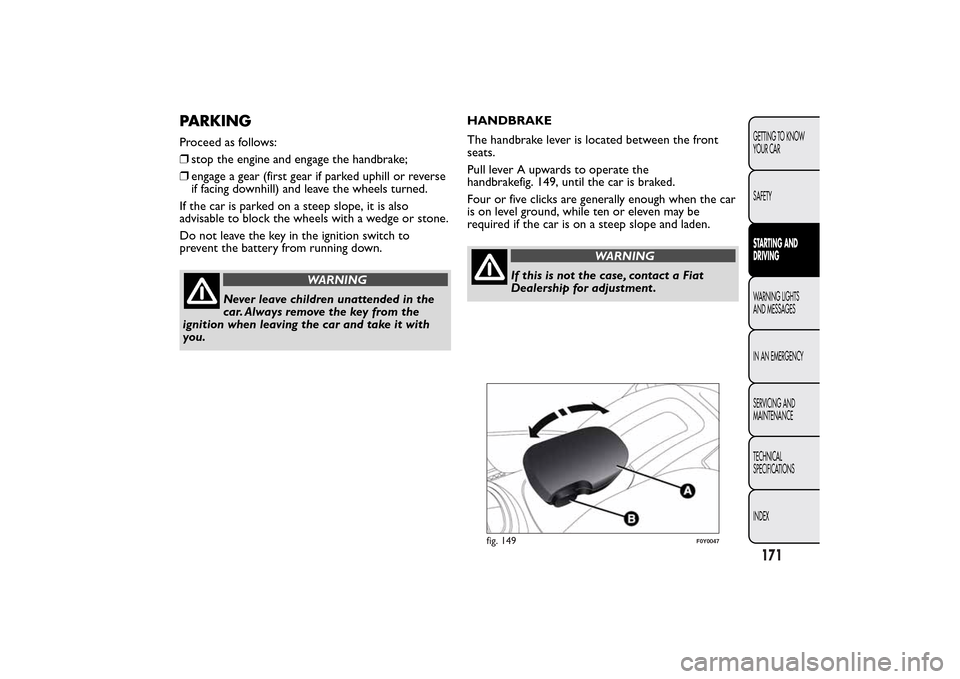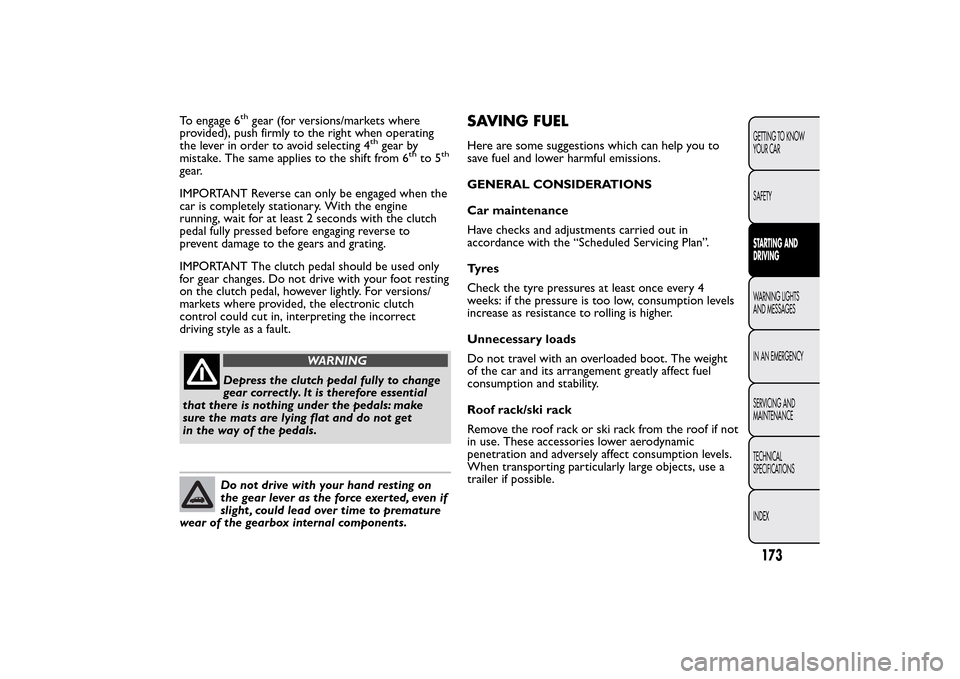Page 175 of 420

PARKINGProceed as follows:
❒stop the engine and engage the handbrake;
❒engage a gear (first gear if parked uphill or reverse
if facing downhill) and leave the wheels turned.
If the car is parked on a steep slope, it is also
advisable to block the wheels with a wedge or stone.
Do not leave the key in the ignition switch to
prevent the battery from running down.
WARNING
Never leave children unattended in the
car. Always remove the key from the
ignition when leaving the car and take it with
you.HANDBRAKE
The handbrake lever is located between the front
seats.
Pull lever A upwards to operate the
handbrakefig. 149, until the car is braked.
Four or five clicks are generally enough when the car
is on level ground, while ten or eleven may be
required if the car is on a steep slope and laden.
WARNING
If this is not the case, contact a Fiat
Dealership for adjustment .
fig. 149
F0Y0047
171GETTING TO KNOW
YOUR CAR
SAFETYSTARTING AND
DRIVINGWARNING LIGHTS
AND MESSAGES
IN AN EMERGENCY
SERVICING AND
MAINTENANCE
TECHNICAL
SPECIFICATIONS
INDEX
Page 176 of 420

When the handbrake is engaged and the ignition key
is on MAR-ON, the instrument panel warning light
will switch on.
Proceed as follows to release the handbrake:
❒slightly lift the lever and press release button B;
❒hold button B down and lower the lever: the
warning light on the instrument panel switches
off.
Press the brake pedal when carrying out this
operation to prevent the car from moving
accidentally.
IMPORTANT For cars equipped with a front
armrest, lift this up to ensure that it does not
interfere with the action of the handbrake.
USING THE GEARBOXTo engage the gears, fully depress the clutch pedal
and put the gear lever into the required position (the
diagram is shown on the knob fig. 150).
For 0.9 TwinAir Turbo 105 HP and 1.4 16V versions,
to engage reverse R from neutral, lift the ring A
fig. 150 under the knob and shift the lever to the
right and back.
For 1.3 16V MultiJet version: to engage reverse R
from neutral position, shift the lever to the right and
then back.
For 1.6 16V MultiJet version: to engage reverse R
from neutral, lift ring A fig. 150 under the knob and
at the same time move the lever to the left and
then forwards.
fig. 150
F0Y0136
172GETTING TO KNOW
YOUR CAR
SAFETYSTARTING AND
DRIVINGWARNING LIGHTS
AND MESSAGES
IN AN EMERGENCY
SERVICING AND
MAINTENANCE
TECHNICAL
SPECIFICATIONS
INDEX
Page 177 of 420

To engage 6
th
gear (for versions/markets where
provided), push firmly to the right when operating
the lever in order to avoid selecting 4
th
gear by
mistake. The same applies to the shift from 6
th
to 5
th
gear.
IMPORTANT Reverse can only be engaged when the
car is completely stationary. With the engine
running, wait for at least 2 seconds with the clutch
pedal fully pressed before engaging reverse to
prevent damage to the gears and grating.
IMPORTANT The clutch pedal should be used only
for gear changes. Do not drive with your foot resting
on the clutch pedal, however lightly. For versions/
markets where provided, the electronic clutch
control could cut in, interpreting the incorrect
driving style as a fault.
WARNING
Depress the clutch pedal fully to change
gear correctly. It is therefore essential
that there is nothing under the pedals: make
sure the mats are lying flat and do not get
in the way of the pedals.Do not drive with your hand resting on
the gear lever as the force exerted, even if
slight , could lead over time to premature
wear of the gearbox internal components.
SAVING FUELHere are some suggestions which can help you to
save fuel and lower harmful emissions.
GENERAL CONSIDERATIONS
Car maintenance
Have checks and adjustments carried out in
accordance with the “Scheduled Servicing Plan”.
Ty r e s
Check the tyre pressures at least once every 4
weeks: if the pressure is too low, consumption levels
increase as resistance to rolling is higher.
Unnecessary loads
Do not travel with an overloaded boot. The weight
of the car and its arrangement greatly affect fuel
consumption and stability.
Roof rack/ski rack
Remove the roof rack or ski rack from the roof if not
in use. These accessories lower aerodynamic
penetration and adversely affect consumption levels.
When transporting particularly large objects, use a
trailer if possible.
173GETTING TO KNOW
YOUR CAR
SAFETYSTARTING AND
DRIVINGWARNING LIGHTS
AND MESSAGES
IN AN EMERGENCY
SERVICING AND
MAINTENANCE
TECHNICAL
SPECIFICATIONS
INDEX
Page 178 of 420

Electrical devices
Only use electrical devices for the amount of time
needed. The heated rear window, additional
headlights, windscreen/rear window wipers and
heater fan need a considerable amount of energy,
therefore increasing fuel consumption (by up to 25%
in the urban cycle).
Climate control system
The use of the climate control system leads to higher
fuel consumption. If the temperature outside
permits, try to use ventilation only.
Devices for aerodynamic control
The use of non-certified devices for aerodynamic
control may adversely affect air drag and fuel
consumption.
DRIVING STYLE
Starting
Do not warm up the engine at low or high revs when
the car is stationary; this causes the engine to warm
up more slowly, thereby increasing fuel consumption
and emissions.
It is advisable to set off immediately and slowly,
avoiding high revs: this allows the engine to warm up
more quickly.Unnecessary actions
Avoid revving up when at traffic lights or before
stopping the engine. This and also double declutching
is absolutely pointless on modern cars and also
increases consumption and pollution.
Gear selection
Use a higher gear as soon as traffic and road
conditions allow. Using a low gear for faster
acceleration will increase consumption.
In the same way improper use of a high gear
increases consumption, emissions and engine wear.
Maximum speed
Fuel consumption increases considerably with speed.
Keep speed as constant as possible, avoiding
unnecessary braking and acceleration, which have a
significant cost in terms of both fuel consumption
and emissions.
Acceleration
Sudden acceleration has a very negative effect on fuel
consumption and emissions: accelerate gradually.
174GETTING TO KNOW
YOUR CAR
SAFETYSTARTING AND
DRIVINGWARNING LIGHTS
AND MESSAGES
IN AN EMERGENCY
SERVICING AND
MAINTENANCE
TECHNICAL
SPECIFICATIONS
INDEX
Page 179 of 420

CONDITIONS OF USE
Cold starting
Short distances and frequent cold start-ups will
prevent the engine from reaching optimal running
temperature.
Consequently, both consumption (from +15 to +30%
on urban cycle ) and emissions will increase.
Traffic and road conditions
Rather high fuel consumption is caused by heavy
traffic, for instance when travelling in a queue with
frequent use of low gears or in large towns with
many traffic lights.
Mountain and rough roads also have a negative effect
on fuel consumption.
Stops in traffic
During prolonged stops (e.g. level crossings) the
engine should be switched off.
TOWING TRAILERSIMPORTANT NOTES
For towing caravans or trailers the car must be fitted
with a type-approved tow hook and an adequate
electrical system. Installation must be carried out by
a specialist.
Install any specific and/or additional rear view mirrors
as specified by the Highway Code.
Remember that when towing a trailer, steep hills are
harder to climb, braking distances increase and
overtaking takes longer depending on the overall
weight of the trail.
Engage a low gear when driving downhill, rather than
constantly using the brake.
The weight of the trailer on the car's tow hook will
reduce the load capacity of the car by the same
amount. To make sure that the maximum towable
weight is not exceeded (given in the car registration
document) account should be taken of the fully
laden trailer, including accessories and luggage.
Respect the speed limits specific to each country for
vehicles towing trailers. In any case, the top speed
must not exceed 100 km/h.
175GETTING TO KNOW
YOUR CAR
SAFETYSTARTING AND
DRIVINGWARNING LIGHTS
AND MESSAGES
IN AN EMERGENCY
SERVICING AND
MAINTENANCE
TECHNICAL
SPECIFICATIONS
INDEX
Page 180 of 420

Any electric brake or other device (winch etc.)
should be powered directly by the battery through a
cable with a cross-section of no less than 2.5 mm
2.
In addition to the electrical branches, the car's
electrical system can be connected only to the supply
cable for an electric brake and to the cable for an
internal trailer light, though not more than 15 W. To
connect, use the preset control unit with a battery
cable with cross-section no less than 2.5 mm
2.
IMPORTANT The use of auxiliary loads other than
external lights (electric brake, winch, etc.) must
occur with engine running.
IMPORTANT To install a tow hook contact a Fiat
Dealership.
WARNING
The ABS with which the car may be
equipped will not control the braking
system of the trailer. Particular caution is
required on slippery roads.
WARNING
Never modify the braking system of the
car to control the trailer brake.The
trailer braking system must be fully
independent of the car ’s hydraulic system.INSTALLING A TOW HOOK
The towing device should be fastened to the body by
specialised personnel according to any additional
and/or integrative information supplied by the
Manufacturer of the device.
The towing device must meet current regulations
with reference to Directive 94/20/EC and subsequent
amendments.
For any version the towing device used must be right
for the towable weight of the car on which it is to
be installed.
For the electrical connection a standard connector
should be used which is generally placed on a special
bracket normally fastened to the towing device,
and a special ECU for external trailer light control
must be installed on the car.
7 or 13-pin 12 V DC connections should be used
(CUNA/UNI and ISO/DIN Standards). Follow any
instructions provided by the car manufacturer and/or
the towing device manufacturer.
Installation diagram for basic versions fig. 151
The tow hook structure must be fastened in the
points shown in the figure with a total amount of 8
fastening points to the body.
176GETTING TO KNOW
YOUR CAR
SAFETYSTARTING AND
DRIVINGWARNING LIGHTS
AND MESSAGES
IN AN EMERGENCY
SERVICING AND
MAINTENANCE
TECHNICAL
SPECIFICATIONS
INDEX
Page 181 of 420
177GETTING TO KNOW
YOUR CAR
SAFETYSTARTING AND
DRIVINGWARNING LIGHTS
AND MESSAGES
IN AN EMERGENCY
SERVICING AND
MAINTENANCE
TECHNICAL
SPECIFICATIONS
INDEX
fig. 15
F0Y111
1
6
Page 182 of 420
Installation diagram for Trekking versions
fig. 152
The tow hook structure must be fastened in the
points shown in the figure with a total amount of 8
fastening points to the body.
WARNING
After fitting, screw holes must be sealed
to prevent a exhaust gas inlet .
178GETTING TO KNOW
YOUR CAR
SAFETYSTARTING AND
DRIVINGWARNING LIGHTS
AND MESSAGES
IN AN EMERGENCY
SERVICING AND
MAINTENANCE
TECHNICAL
SPECIFICATIONS
INDEX